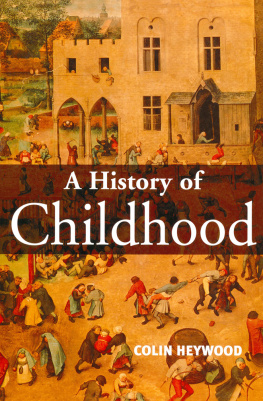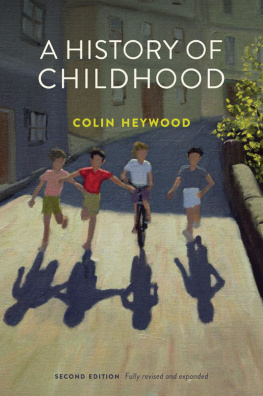The International Library of Sociology
CHILDREN IN CARE
Founded by KARL MANNHEIM
The International Library of Sociology
THE SOCIOLOGY OF YOUTH AND ADOLESCENCE
In 12 Volumes
| I | Adolescence | Fleming |
| II | Adolescents and Morality | Eppel and Eppel |
| III | Caring for Children in Trouble | Carlebach |
| IV | Casework in Child Care | Kastell |
| V | Children in Care | Heywood |
| VI | Delinquency and Opportunity | Cloward and Ohlin |
| (The above title is not available through Routledge in North America) |
| VII | Family Environment and Delinquency | Glueck and Glueck |
| (The above title is not available through Routledge in North America) |
| VIII | German Youth: Bond or Free | Becker |
| IX | A Psychoanalytical Approach to Juvenile Delinquency | Friedlander |
| X | Studies in the Social Psychology of Adolescence | Richardson and Forrester et al |
| XI | Working with Unattached Youth | Goetschius and Tash |
| XII | Youth and the Social Order | Musgrove |
CHILDREN IN CARE
The Development of the Service for the Deprived Child
by
JEAN S. HEYWOOD
First published in 1959
by Routledge
Reprinted in 1998, 2001
by Routledge
2 Park Square, Milton Park, Abingdon, Oxon, OX14 4RN
Transferred to Digital Printing 2007
Routledge is an imprint of the Taylor & Francis Group
1959 Jean S. Heywood
All rights reserved. No part of this book may be reprinted or reproduced or utilized in any form or by any electronic, mechanical, or other means, now known or hereafter invented, including photocopying and recording, or in any information storage or retrieval system, without permission in writing from the publishers.
The publishers have made every effort to contact authors/copyright holders of the works reprinted in The International Library of Sociology. This has not been possible in every case, however, and we would welcome correspondence from those individuals/companies we have been unable to trace.
Library of Congress Cataloging-in-Publication Data
A CIP catalogue record for this book
is available from the British Library
Children in Care
ISBN0-415-17662-X
The Sociology of Youth and Adolescence: 12 Volumes
ISBN 0-415-17828-2
The International Library of Sociology: 274 Volumes
ISBN 0-415-17838-X
Publisher's Note
The publisher has gone to great lengths to ensure the quality of this reprint but points out that some imperfections in the original may be apparent
To
MY MOTHER AND FATHER
CONTENTS
PREFACE
THIS book was written primarily to help my students to explore the changing social patterns and ideas which lie behind the history of attention and care given to the deprived child. But it tells also a story of human struggle, endurance and inspiration which seems to me to belong not only to the professional social worker but to the people and the community at large, and to them I offer it in the hope that it will interest them.
I should like to express my gratitude to those who have so generously helped me to refer to the wealth of material bearing on this subject, almost every aspect of which, I am well aware, could be the study of a lifetime. In particular I should like to mention Lady Allen of Hurtwood; Commander C. R. Burgess, R.N., Secretary of the Marine Society; Mr. John W. Cox of the Department of History, University of Leeds; Miss Joan M. Dorrell; the Very Rev. Canon C. B. Flood of the Crusade of Rescue; Mr. F. W. Esbester, Assistant Secretary of the Church of England Children's Society; Mr. A. C. Greg; Mr. S. H. Henshall of the Quarry Bank Mill, Styal; the Rev. Walter C. Lazenby; the Rev. John W. Waterhouse, Principal of the National Children's Home; the Feoffees of Chetham's Hospital; the Secretary of the Thomas Coram Foundation for Children; the Home Office Inspectorate; the National Trust; and the Librarians of the City Reference Libraries of Leeds and Manchester, of the Brotherton Library, University of Leeds, and of the Municipal Library, Middleton, Lancashire, who, courteously and unfailingly, met all my many demands upon them. I thank also Mrs. Lilley and Miss Margaret Field for their patient work with the drafts.
To my friends and colleagues Mrs. Barbara N. Rodgers of the University of Manchester and Miss Alice Eden of Homerton College, Cambridge, Miss Marion Jones and Mr. A, C. McBryan, Children's Officers of Burnley and Bury respectively, who read through my typescript and made many corrections and constructive suggestions and criticisms I am very grateful, and also to Mr. Kenneth Brill, Secretary of the Children's Officers' Association, and to my brother, John B. Heywood, who read through the proofs and gave me throughout the work much sound and invaluable advice and help.
My thanks are due to the writers and publishers who have given me permission to quote from their books. Acknowledgement of them will be found in the footnotes and in the bibliography.
I would finally like to express my gratitude to Professor E. Grebenik and Miss Ida E. Brown of the Department of Social Studies, the University of Leeds, whose continual challenge, stimulation and encouragement enabled me to write this book, and to whose teaching I owe a debt which I can never adequately discharge.
JEAN S. HEYWOOD
September, 1958.
CHAPTER ONE
THE CHILD IN THE EARLY COMMUNITY
T HERE is little positive evidence for the care of the deprived child in English history before the Reformation. Most of it has to be pieced together from casual references, the absence of information about the deprived child at this time being just as significant as would have been copious references to him. The manorial group of medieval society was self-sufficient and room could be found for the homeless child within the community, in the cottage of the childless villein or to replace those sons of villeins who had gained permission from the lord to leave the manor to become clerks or monks. Such children were mostly orphans who could not be cared for by relatives, or were illegitimate. The illegitimate child was completely without rights, the property of the mother's master, if she were a servant1, and the Church, in upholding the sanctity of marriage, condemned his very existence, forbidding him to inherit or to be ordained. Yet while he was nobody's child, he was also the child of the people,2 and some community obligation was implied towards him. Then, as now, the natural families absorbed him and the motherly and childless, whose poverty was not too great, were glad to care for him. Sometimes a distant relative would take him in, particularly if his mother was an erring daughter of the Church, who, like Langland's nun, had borne a child in cherry time, to the scandal of the parish.3
In practice the distinction between the legitimate and the illegitimate appears to have been a largely artificial one, however, and bastards were acknowledged by fathers and provided for in wills equally with the legitimately born,1 while special dispensations to enable illegitimate sons to be ordained or hold ecclesiastical office were frequent.2 Among the wealthy it was not difficult to find a wet nurse and afterwards to send the child, along with lawful children, to a monastery or nunnery for boarding education, or to the house of some other member of the nobility. Trevisan, an Italian who in 1496 accompanied an ambassador from Venice to the English court, describes this as the usual practice for all children among the well-to-do after they reached the age of seven or nine. He ascribes it to the want of affection in the English & because they like to enjoy all their comforts themselves, and think they are better served by the children of strangers than they would be by their own children.3 This form of deprivation existed in the middle ages as a commonplace among the prosperous families. Many children of the nobility spent the greater part of their childhood away from home, in ecclesiastical houses or homes of the wealthy, while their parents, for example, were holding office abroad; and when child and parent were incompatible such arrangements seemed sometimes a convenient and easy solution to an exasperated and weary mother. For this we have the testimony of Margaret Paston writing to her son in 1469:Also I would ye should purvey for your sister to be with my lady Oxford or with my lady of Bedford, or in some other worshipful place whereas ye think best, for we are either of us weary of each other.











